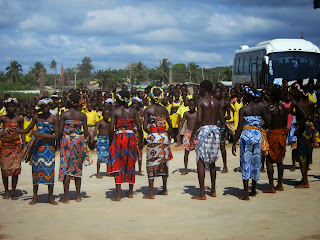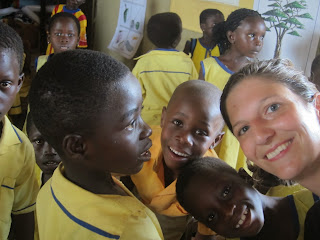The day we arrived in Ghana, Jason and I were eating breakfast on the outside deck when we heard drumming. I ran to the rail, looked over, and saw an African dance and drumming group performing just outside. The ship hadn't yet been cleared and we couldn't get off, but they were welcoming us all to Takoradi. It was a wonderful surprise.
 |
| More rhythm than I will ever have. |
That day I was supposed to help out with a field lab (class trip) to the castles and dungeons where British and Dutch traders had storehoused slaves for months before shipping them to the New World. Jason was scheduled to go to the same place on a separate trip, so we were going to have the same experience, but separately.
We had been warned that traffic in Ghana was absolutely terribly, but it was doubly so our first day because it was Eid. Eid is a Muslim holiday, and quite a bit of Ghana is Muslim. Everyone was out pilgrimaging through the streets, singing and chanting. They didn't seem to care that they were actually in the street and backing up traffic. The bus driver didn't seem too perturbed either. It was wonderful to observe everyone dressed up and to start to understand this holiday.
 |
| The guy under the beach umbrella is the tribal chief. |
One of the slave castles, used by the British, was called Cape Coast. It was absolutely gorgeous, right on the water and lined with palm trees, but incredibly depressing. Thousands of slaves lived in tiny, unventilated dungeons for months before being shipped to the Americas. An incredible percentage of them died before getting on the ships, mostly as the result of living in close and incredibly unsanitary quarters. Others were beaten to death or starved as punishment. The contrast between the beautiful scenery and what happen there was hard to stomach. I don't have pictures of the inside as you had to buy a photo permit, but I do have some of the surroundings.
 |
| The outside of the Cape Coast Castle |
 |
| The fishing village right outside the castle. The blue-green stuff is their nets. |
The fishing village located right outside the "Door of No Return," where the slaves exited to board the ships, was beautiful to see as well. None of the fishermen were out fishing as it was a Tuesday and the sea gods rest on Tuesdays so it isn't a good idea to go out. All of the boats were dugout canoes with outboard motors and flags from around the world, including the US! The people don't have any particular affiliation with those countries, they just like the colors or something about the country they pick.
After the first castle we headed to the Coconut Grove Resort for lunch. After seeing the poverty of the fishing village and hearing about the slave trade, it was kind of shocking to go to a beautiful, upscale beach resort. The food was pretty good (Ghanian food isn't really my thing though) and the views were incredible. Unbeknownst to us, Jason's trip was eating at the same place, so we were able to enjoy a few minutes on the beach together. It was absolutely gorgeous.
 |
| Coconut Grove |
 |
| It was so incredibly hot and humid in Ghana that we were very excited to wade a bit in the ocean. |
After lunch my group went to the Dutch castle, Elmina. Jason's had gone to Elmina in the morning and then headed to Cape Coast. Elmina was much the same as Cape Coast, although here we learned a bit more about the awful treatment of women. We also saw the cell where prisoners who tried to escape were chained together and left to starve to death. When one died, their body was left in the cell with the still-alive prisoners. It was horrible.
 |
| Punishment cell |
 |
| Cannons for defense against pirates |
Near Elmina was another fishing village, this one much larger. We didn't get to go in, but it was a riot of colors and tons and tons of boats.
 |
| Fishing village of Elmina |
The slave castles were a very powerful experience and we're so glad we had the chance to see them.




















.jpg)



.jpg)




























